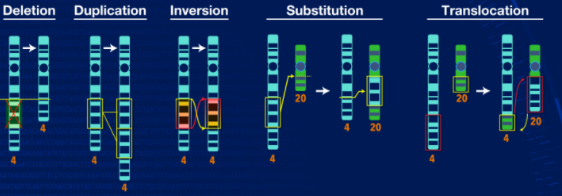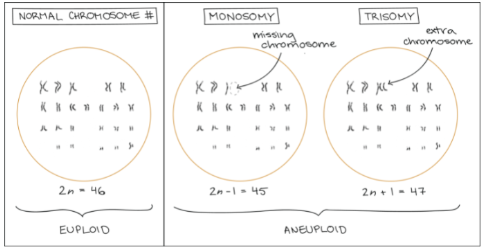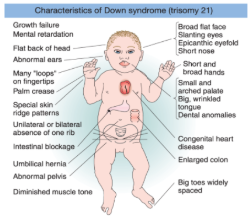1. Chromosome abnormalities in human disease
1/12
There's no tags or description
Looks like no tags are added yet.
Name | Mastery | Learn | Test | Matching | Spaced |
|---|
No study sessions yet.
13 Terms
What are the 4 types of human genetic disease?
Single gene disorders
Genetic components of complex diseases
Chromosomal abnormalities
Mitochondrial diseases
Chromosomal disorders
What is aneuploidy?
Name 3 examples of aneuploidy
Extra or lost chromosomes.
Examples of aneuploidy:
Down Syndrome (trisomy 21 - 3 copies of chromosome 21)
Klinefelter syndrome (XYY - extra copy of chromosome Y)
Turner syndrome (X0 - don’t have a second sex chromosome)
Chromosomal disorders
What changes in chromosome structure could occur to cause chromosomal disorders (5)?
Deletions (e.g resulting in 5p deletion syndrome)
Duplications
Inversions
Reciprocal translocations
Robertsonian translocations (specific translocation, more commonly seen, one of the ways you can get down syndrome)

Polyploidy vs Aneuploidy
What is polyploidy?
What is aneuploidy?
Polyploidy is the number of copies of whole sets of chromosomes.
Aneuploidy is a chromosome aberration where the chromosome number is abnormal - not a difference in number of sets but a difference in numbers of individual chromosomes.
Aneuploidy
What syndromes of aneuploidy can you have?
Describe what each means.
Monosomy and trisomy.
Monosomy is missing a chromosome (2n - 1 = 45 chromosomes), whereas trisomy is an extra chromosome (2n + 1 = 47 chromosomes).

Down Syndrome (trisomy 21)
How is down syndrome caused?
What is there usually no family history of?
What could some rarer types of down syndrome arise from?
Of human trisomies, the most familiar type is Down syndrome.
Most affected persons have an extra copy of chromosome 21 caused by nondisjunction of chromosome 21 in a parent who is chromosomally normal.
In this sporadic type of Down syndrome, there is no family history of aneuploidy.
Some rarer types of Down syndrome arise from translocations; in these cases, Down syndrome recurs in the pedigree because the translocation may be transmitted from parent to child.

Down Syndrome (trisomy 21)
Describe the possible phenotypes of someone with Down Syndrome.
What is the difference in fertility between men and women with Down Syndrome?
What is the life expectancy now of someone with Down Syndrome?
The combined phenotypes that make up Down syndrome include:
Mental retardation (with an IQ in the 20 to 50 range)
A broad, flat face
Eyes with an epicanthic fold (a skin fold of the upper eyelid that covers the inner corner of the eye)
Short stature
Short hands with a crease across the middle
A large, wrinkled tongue.
Females may be fertile and may produce normal or trisomic progeny, but males are sterile with very few exceptions.
Due to improvements in the care of individuals with Down syndrome, the average life expectancy is now 60 years.

(other) Human autosomal trisomics
What is Patau syndrome a trisomy of?
What are the phenotypes of Patau syndrome?
What is the life expectancy of someone with Patau syndrome?
Trisomy of chromosome 13 (trisomy 13).
Phenotypes:
Severe physical and mental abnormalities
Harelip
Small head
Rocker-bottom feet
Life expectancy of 130 days.
(other) Human autosomal trisomics
What is Edwards syndrome a trisomy of?
What are the phenotypes of someone with Edwards syndrome?
What is the life expectancy of someone with Edwards syndrome?
Trisomy of chromosome 18 (trisomy 18).
Phenotypes:
Severe physical and mental abnormalities
‘faunlike’ ears
Small jaw
Narrow pelvis
Life expectancy – several weeks
What are the human autosomal trisomic disorders and why aren’t there any more?
Human autosomal trisomic disorders:
Down syndrome (trisomy 21)
Patau syndrome (trisomy 13)
Edwards syndrome (trisomy 18)
All other trisomics die in utero.
Klinefelter syndrome
What is different about the viability of sex chromosome trisomics and autosomal trisomics?
What causes Klinefelter syndrome?
What are the phenotypes of this syndrome?
There are several examples of viable human trisomies. Several types of sex-chromosome trisomics can live to adulthood, whereas there are only 3 autosomal trisomics that won’t die in utero.
The combination XXY results in Klinefelter syndrome.
Phenotypes:
Males who have a more feminised, lanky build
A female type pubic hair pattern
Small testes
Risk of osteoporosis
Absent frontal baldness
Mildly impaired IQ
Sterile

Turner syndrome
What causes Turner syndrome?
How common is it?
What are some of the phenotypes?
What is this the only example of?
X0 - Only one copy of chromosome X - nothing where the other X would be.
1/5000 female births.
Phenotypes:
Short stature
Low hairline
Shield shaped thorax
Widely spaced nipples
Increased risk of moles
No menstruation
Rudimentary ovaries
Poor breast development
Constriction of the aorta
This is the only viable monosomy.
We know about the sex chromosomes and trisomies 21, 13 and 18, what about the other chromosomes?
Why do you think there are not syndromes associated with trisomy or monosomy of the other chromosomes?
Why might monosomies of the sex chromosomes be more tolerated?
The other monosomies and trisomies are not viable.
It’s ‘natural’ to be monosomy for sex chromosomes (all XY individuals are monosomy for X and Y). Mammals have an elaborate system for dealing with this called ‘X inactivation’. This same mechanism can deal with extra copies of X chromosomes. At meiosis, extra sex chromosomes are lost without causing much trouble, so many individuals with sex chromosome aneuploidy are fertile.